Looking for the best measurement worksheets on the internet? Look no further! Our measurement worksheets are designed to help students of all ages learn and practice the important skill of measurement. From length and weight to volume and capacity, our worksheets cover a wide range of topics to ensure a well-rounded understanding of measurement concepts. And the best part? They're all free! Simply download and print as many copies as you need for your classroom or home use. These measurement worksheets are a great resource for teachers, students, and parents looking to improve their measurement skills. Try them out today and see the difference they can make in your understanding of measurement.
Browse Sheets By Problem Type
×
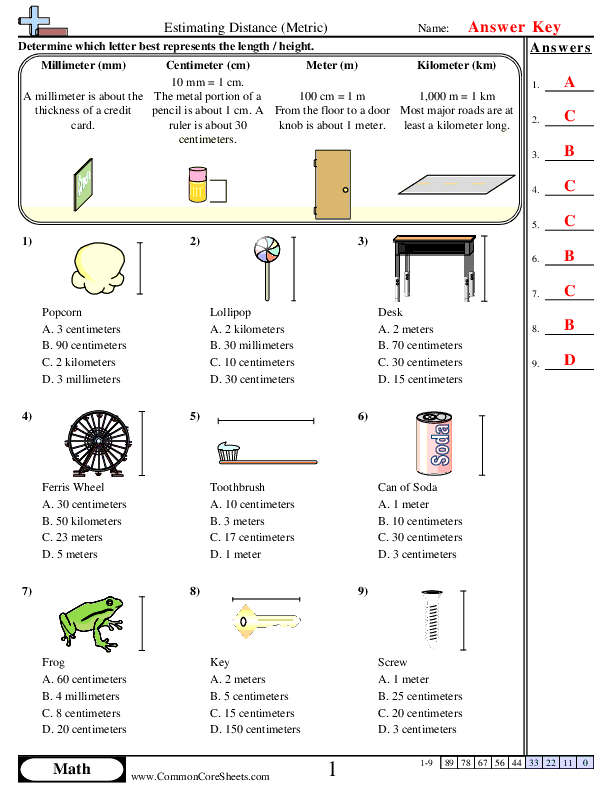
Estimating Length (Metric)
4md1


×
Description:
"This worksheet is designed to enhance children's mathematical skill in estimating distances using the metric system. Comprising nine problem sets, it employs everyday items, from shovels to envelopes, to facilitate comprehension. Perfect for distance learning, these problems can be converted into customizable flashcards for effective learning and easy recall."

×
Student Goals:
Understand Distance MeasurementAfter successfully completing this worksheet, students should attain a comprehensive mastery of distance measurements in metric units. They should be able to recognize and differentiate between millimeters, centimeters, meters, and kilometers, understanding how they relate to each other and how they are used to represent lengths and distances in the real world.Estimating TechniquesFurthermore, students will develop the skill to make accurate estimations. They will be able to gauge the distances of various everyday items without employing measuring instruments, based on their understanding of the comparative lengths of different metric units. Hence, they will understand the application of these units in day-to-day scenarios.Critical Thinking and Problem SolvingWith the knowledge obtained from the worksheet, students should be equipped with better problem-solving and critical thinking abilities. They will be capable of making smart choices from provided options in estimating the length or distance of things. This will be especially useful in instances where precision measuring tools are not readily accessible.Application to Real-life ContextsFinally, students should be able to apply the skills learned in practical real-world contexts. They will understand that the same methods used in estimating the length of a glue stick, or the distance covered in a trip, can be used to solve more complex mathematical problems.Relevance in Other Subject AreasThis knowledge will be useful in overcoming challenges not only in Math but also in other subjects that require measurements such as Science and Geography. For instance, having a good grasp of distances could aid in the study of habitats or geographical features.Build ConfidenceCompletion of the worksheet can build confidence in students, as they would be able to see that mathematics and measurements are concepts that they can grasp and use in their everyday lives. This could lead to a deeper interest in math and other related subjects, encouraging them to explore these further.


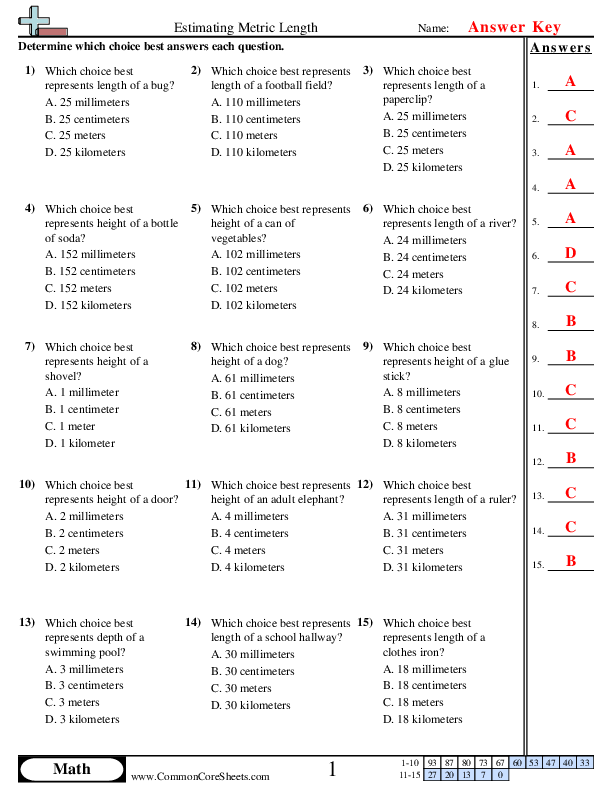
Determining Appropriate Measurement (Metric)
4md1


×
Description:
"This worksheet is designed to help children practice estimation of metric lengths. It offers 15 mathematical problems dealing with real-world objects, varying from daily household items to larger landscapes, to improve the grasp of metric units. This versatile aid can be customized based on a learner's level, transformed into flashcards for revision, or incorporated into distance learning curriculums to effectively and engagingly teach metric length estimation."

×
Student Goals:
Understanding of Metric UnitsAfter completing the worksheet, students should have gained a clear understanding of various metric units of length such as millimeters, centimeters, meters, and kilometers. They will also comprehend how these units relate to real-world objects, enhancing their understanding of metric scales.Problem Solving SkillsThe worksheet aims to enhance critical thinking and problem-solving skills in a student. As they navigate through the problems, they are encouraged to make logical decisions on what metric units best represent the given objects—thus, equipping them with fundamental problem-solving abilities.Practical Application of Math ConceptsPost worksheet completion, students should be able to apply the mathematical concepts learned in practical scenarios. They will be equipped to estimate and measure lengths of various objects around them accurately using the correct metric units.Conceptual KnowledgeStudents will also assimilate conceptual knowledge about the size and scale of everyday items, which will be beneficial not only in their mathematical journey but also in general cognitive development. They will understand the typical length of objects, their comparison, and get a sense of spatial awareness.Improved Estimation SkillsThe worksheet is designed to help students significantly improve their estimation skills. By solving problems that involve estimating the length of various items, students will develop a better sense of judgment. They will learn to make accurate estimates, a skill that is essential in many areas of life beyond math.Strengthens Logical ReasoningUpon completion, students should exhibit improved mental agility and logical reasoning. Probing the metric length of everyday objects and comparing choices demands regular practice for cognitive development, which in turn strengthens their logical reasoning skills.Confidence in Handling MeasurementsStudents will attain familiarity and confidence in dealing with measurements in their day-to-day encounter. By linking realistic objects to measurements, theoretical concepts of metrics and measurements become more approachable and less abstract.


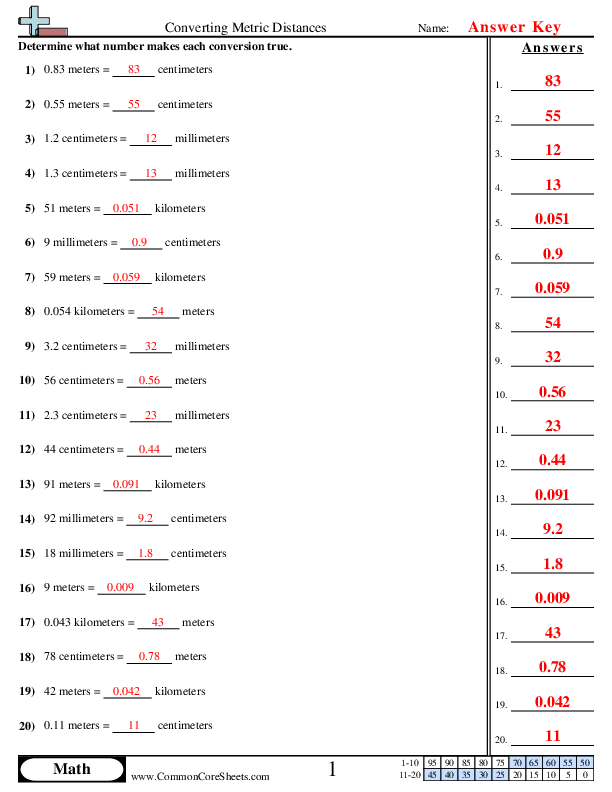
Converting Metric Distances


×
Description:
"This worksheet is designed to support children's understanding of metric conversions in mathematics. Featuring 20 varied problems, it explores concepts such as changing meters to centimeters, millimeters to centimeters, and kilometers to meters. The engaging and dynamic format allows for customization, transformation into flash cards, and is ideal for distance learning environments to amplify children's grasping of metric distance conversions."

×
Student Goals:
Understanding Metric UnitsBy completing this worksheet, students will have developed a strong understanding of standard metric units of distance, including millimeters, centimeters, meters, and kilometers. They will know and understand the relationship between these metric units and be able to convert distances between them effortlessly. This understanding is fundamental in both math and science.Enhanced Problem-Solving SkillsThis worksheet aims at enhancing problem-solving skills. By figuring out conversions between different metric measurements, students will learn to approach math problems logically and systematically. Mastering these skills will not only make them proficient in the math subject but also apply logic in different real-life situations.Accuracy and PrecisionThe completion of this worksheet assures that students can accurately and precisely perform metric conversions. An important mathematic skill, precision plays a significant role in measurements. The skill will also help them to be more meticulous and attentive to details in real-world situations where measurements are required.Improved Math FluencyPost completion of the worksheet, students should demonstrate improved math fluency. They should be able to perform quick calculations and metric conversions without heavily depending on calculators. This will increase their confidence in dealing with numbers, thereby improving their overall mathematical competence.Real World ApplicationBy understanding metric conversion, students will be able to apply these concepts in real-world. Whether they are shopping, cooking, calculating distances, or dealing with scientific measurements, the knowledge and skills they gain from this worksheet will be highly beneficial in numerous practical scenarios.Reinforcement of Core Mathematical SkillsThe worksheet serves to reinforce important mathematical skills. As they focus on the calculation aspect of metric conversion, they concurrently enforce their basic arithmetic skills such as multiplication and division. This overlapping of skills helps define relationships between different mathematical areas and contributes to their overall core mathematical knowledge.


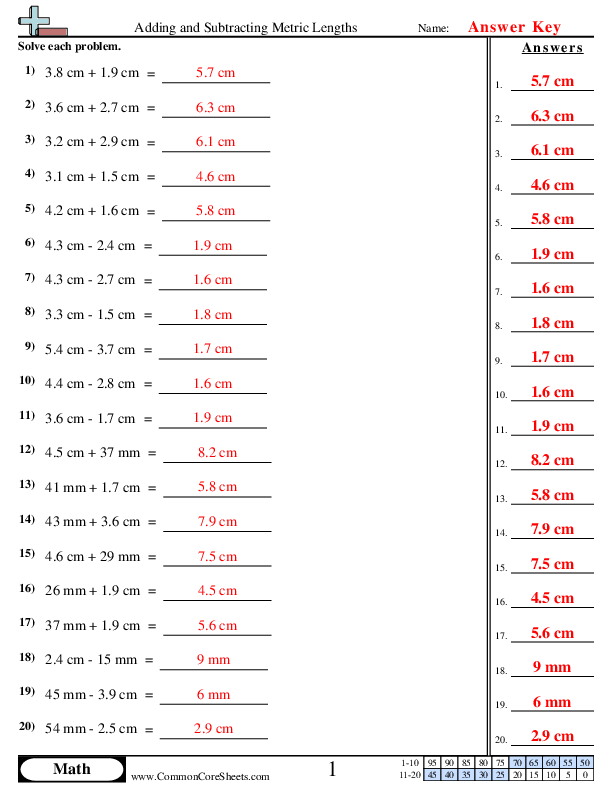
Adding and Subtracting Metric Lengths


×
Description:
"This worksheet is designed to help children master the concept of adding and subtracting metric lengths. It contains 20 problems, each illustrating the applications of math to measurement. The flexible nature allows it to be customized to individual learning needs, converted into flashcards for beneficial repetition, or utilized in a contemporary distance learning setting. A crucial tool for understanding metric system in a fun and engaging manner."

×
Student Goals:
Understanding Metric LengthsAfter completing the worksheet, students should have a firm grasp of metric lengths and their application in simple mathematical problems. They are expected to be efficient in the conversion of measures such as cm to mm, which is crucial in understanding real-world applications related to measurement.Mastering Addition and SubtractionConcentration on addition and subtraction within the worksheet will enable students to improve their aptitude in these fundamental mathematical operations. They can fluently add and subtract different metric lengths, making them proficient in dealing with questions that require these skills.Developing Problem-solving skills and Mathematical ReasoningThe worksheet provides a hands-on experience in solving problems related to adding and subtracting metric lengths, offering a fun way to develop their problem-solving skills. Through these problems, students enhance their mathematical reasoning abilities as they familiarize themselves with the concepts underlying these operations.Improving Mental Math SkillsAs students practice and solve the problems in the worksheet, they will inherently improve their mental math skills. The process of adding or subtracting metric lengths promotes quick thinking and mental computation, skills that are important in their overall intellectual development.Enhancing Accuracy and SpeedThe multitude of problems presented in the worksheet gives students ample practice, which is key to boosting their accuracy and speeding up their mathematical computations. They should be able to work out similar problems in the future with minimal errors and in a shorter amount of time.Applying Knowledge in Real-world ContextsUpon completion of the worksheet, students should be able to apply their learning in real-world contexts. Understanding how to add and subtract metric lengths is more than just a classroom exercise. It is a valuable life skill, useful in scenarios like calculating distances, measuring lengths in science experiments, and more.


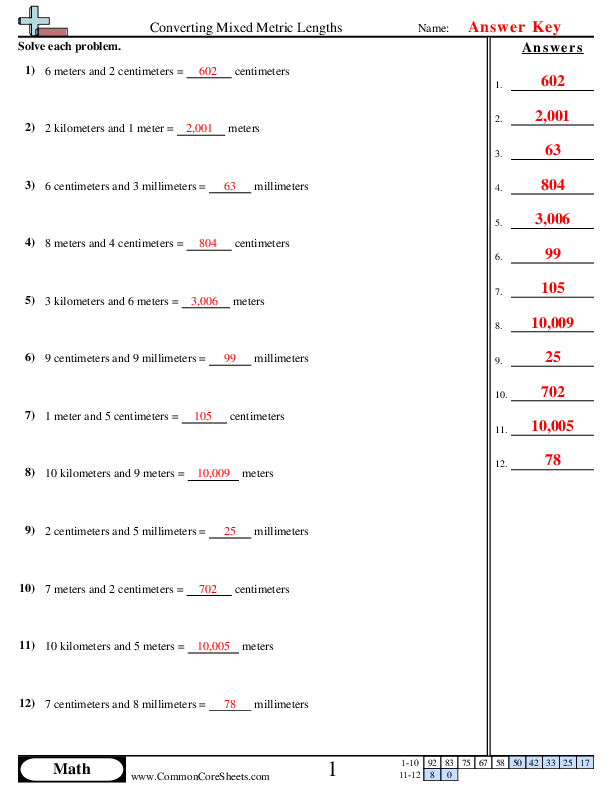
Converting Mixed Metric Lengths


×
Description:
"This worksheet is designed to enhance children's mathematical abilities in converting mixed metric lengths. It contains 12 instructive problems that require kids to convert measurements like kilometers, meters, centimeters, and millimeters. Ideal for distance learning, this versatile worksheet can also be customized or transformed into flashcards for a more interactive learning experience."

×
Student Goals:
Understanding of the Metric SystemUpon completion of this worksheet, students should have gained a better understanding of the metric system. They would have exercised their ability to convert lengths in the metric system, which includes being able to accurately convert kilometers to meters, meters to centimeters, and centimeters to millimeters, and vice versa. This not only enhances their fluency in maths but also equips them with practical skills for solving real-life problems that involve measurements.Problem Solving SkillsAs students navigate through the depicted math problems, they would reinforce their problem-solving skills. The worksheet encourages students to apply their knowledge while finding solutions, which helps them to attain a higher cognitive level. By finding solutions to the conversion of mixed metric lengths, they would also understand how to apply their knowledge in different scenarios, and generalize their learning into various contexts.Precision and AccuracyAfter completing this worksheet, the students should have developed an understanding of the precision and accuracy in mathematics. Whether counting, adding, measuring, or comparing values, an appreciation for the preciseness and accuracy required in retrieving measurements and quantitative information is developed. This precision not only applies to the mathematical world but also plays a significant role in scientific investigations and daily life.Development of Quantitative SkillsThis worksheet helps students to boost their mathematical skills specifically dealing with numbers and figures. The students would be more comfortable dealing with large numbers, and different units of measurement, converting between them swiftly and accurately. The skill set can be beneficial in various scenarios, from calculating distances to understanding quantitative data in academic research.Confidence with MeasurementsHandling numbers and units should become more familiar to students after completing the worksheet. As they grow a better understanding of the metric system and how its components relate, they should become more comfortable and confident using these measurements. This fluency is vital across many academic subjects and will play a significant role in future studies.







